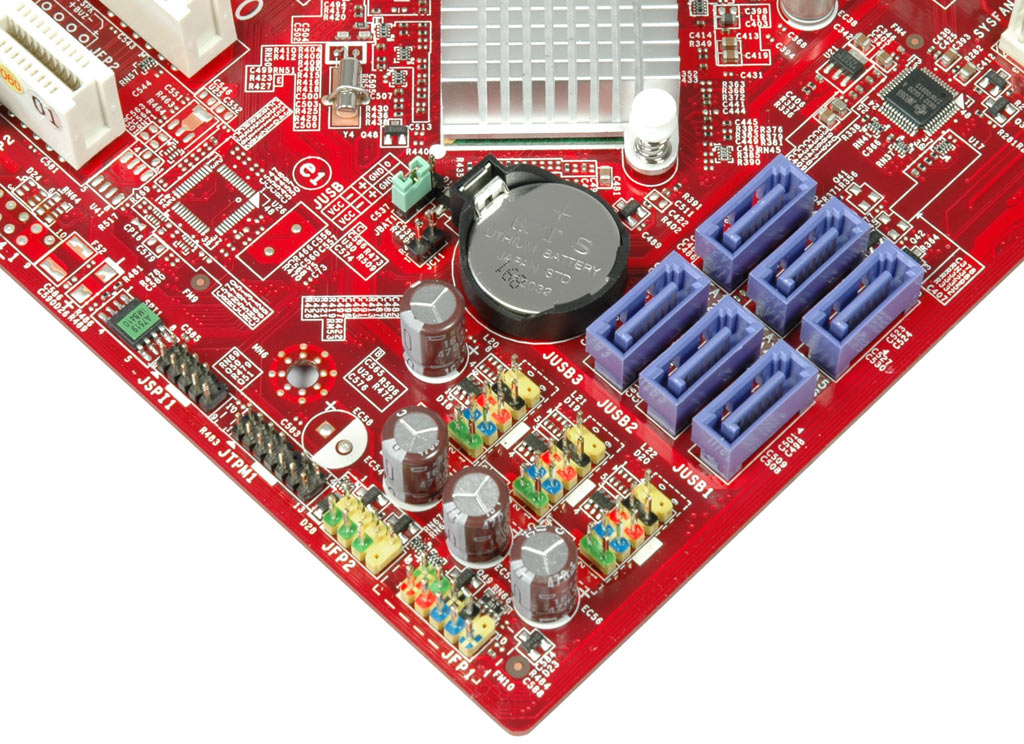Overclocking Core 2 Duo: Power Versus Performance
Platform: MSI P45D3 Neo-F (P45)
The main focus for this product seems to be Europe, as we found more shops carrying this board there than in North America. The product is labeled as being a “Classic Series” motherboard, which you can tell by the simple box design and reasonable number of add-ons. The box is a simple, brown cardboard box and simply has a few stickers instead of an expensive, glossy print. We perceive not being drowned in marketing promises on product boxes as a good thing, especially for a reasonable mainstream motherboard.
Simplicity dominates the design of the PCB. There are heat sinks for the P45 northbridge and the ICH10 southbridge, but no heat pipes and no coolers for the voltage regulators. Traditionally, MSI has been conservative in deploying multiple phases for the voltage regulators, meaning that they might run hotter on overclocked quad-core processors, but they’ll also operate at higher efficiency than six-phase or more complex configurations.
Capacitors in all high-current circuits are solid, although those on secondary circuits are not. Four DDR3 sockets accept DIMMs in dual-channel configurations. The board has a single x16 PCI Express 2.0 slot for graphics and two more x1 PCI Express slots. However, it also has three 32-bit PCI 2.3 slots, which is beneficial if you need to run legacy cards. This board does not support RAID, but it does have a special switch for easy overclocking.
Overclocking Switches
While most motherboard manufacturers have been focusing on extensive BIOS options to facilitate overclocking for the beginner—or complicate overclocking in case you’re an enthusiast—MSI took steps to simplify the process. The P45D3 Neo-F offers a block of DIP switches that you can use to manually switch the board to overclocked settings without having to do any BIOS modifications. While this isn’t suitable for enthusiasts, it is actually a powerful tool for beginners. Imagine installing a Core 2 Duo E7300 2.66 GHz processor, for example; you can easily overclock this one by switching from FSB1066 to FSB1333 speed. The result is 3.33 GHz, which is reliable on all of these CPUs.
Although PS/2 connectors for keyboard and mouse are all but dead, MSI decided to keep these, as well as a conventional serial port. Both allow upgrade users to keep their input devices, and the COM port doesn’t hurt either, unless you'd prefer lots of USB 2.0 ports. The chipset supports a total of 12 USB ports, but only six are available on the I/O panel. Gigabit networking and HD audio are mandatory these days and are present, but it would still have been nice to find a digital audio output as well. MSI was thorough in adding legacy components such as the IDE controller, which provides a single UltraATA/133 connector.
The ICH10 southbridge supports six AHCI Serial ATA/300 ports with Native Command Queuing (NCQ). This feature is important for hard drives, as it allows them to line up pending commands, analyze them, and execute them in the order that causes the least amount of head movement. More and more, solid state drives (flash SSDs) also utilize NCQ together with on-board cache memory. In these cases, NCQ and caching are used to optimize access to the flash memory matrix for the sake of maximizing write performance while maintaining optimal flash wear leveling.
Get Tom's Hardware's best news and in-depth reviews, straight to your inbox.
The P45D3 Neo-F also has front panel connectors for the power and reset switch, and LEDs.
Three voltage regulator phases are sufficient to reliably run Core 2 Quad processors, and more than enough for our Core 2 Duo overclocking.


Unfortunately, a long graphics card will interfere with three of the six SATA ports if you use a dual-slot graphics card such as the Geforce GTX 260 Core 216 we chose for this project. This should probably be looked into, as the board provides a reasonable basis for creating a decent system at a fair price, while offering sufficient overclocking support.
Current page: Platform: MSI P45D3 Neo-F (P45)
Prev Page Processor: Core 2 Duo E8600 Next Page Test Details and Overclocking




